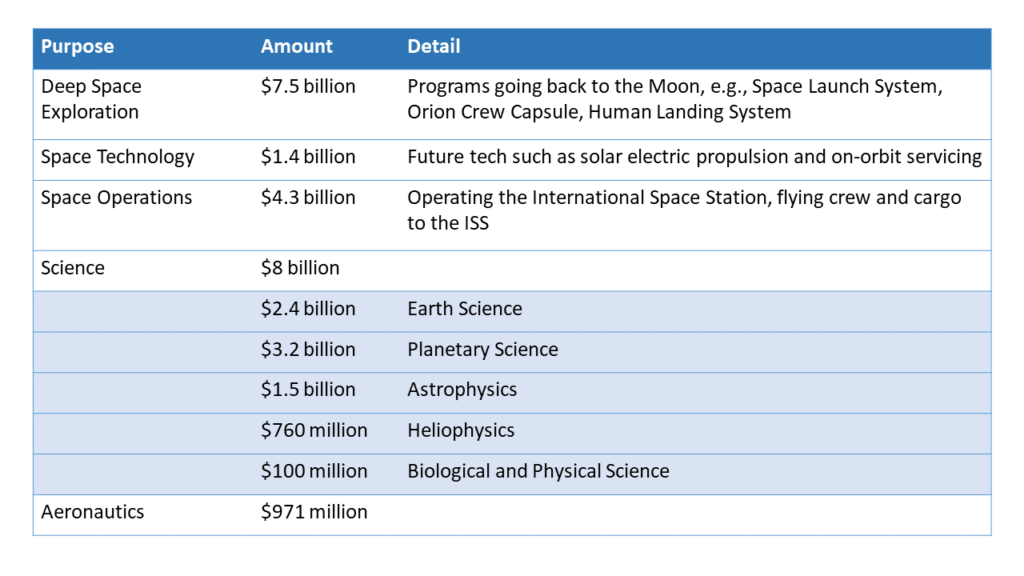
What does the U.S. government spend on space?
Not an easy question to answer but more than $44 billion for fy 2022:
- About $20 billion appropriated to DOD for space–most of it going to the U.S. Space Force.
- $24 billion appropriated to NASA.
Money is also appropriated to NOAA for weather satellites, Department of Energy for some space-related technology development, and of course, the intelligence community, among other space-related activity.
The Administration budget request FY 2023 increased for both NASA–$26 billion and DOD Space Force–$24.5 billion.
NASA BREAKDOWN FOR 2023 BUDGET REQUEST



Space Force’s 2023 budget request for major programs.




Most expensive ongoing unclassified space programs
| Missile Warning Satellites (SBIRS) | $20.7 billion |
| Protected Communications (AEHF) | $16.1 billion |
| Orion Crew Capsule | $12.1 billion |
| Space Launch System (SLS) | $11.8 billion |
| GPS IIIF Satellites | $9.7 billion |
| James Webb Telescope | $9.6 billion |
| Next Generation Missile Warning (OPIR)* | $8.4 billion |
| GPS Ground System (OCX) | $6.7 billion |
| GPS III Satellites | $6.0 billion |
| Wideband Communications (WGS) | $5.0 billion |
Which agencies acquire and use satellites?
- NASA, of course! Everyone knows that NASA is in the space business, building satellites and other spacecraft to explore the universe, understand our planet and climate, and advance science and space technology.
- NOAA. The National Oceanic Atmospheric Administration within the Department of Commerce acquires satellites to monitor and understand the earth. NOAA satellites are behind your local weather reports.
- DOD. The Department of Defense builds and satellites to help maintain national security. These include communications and reconnaissance satellites as well as the Global Positioning System. Yes, the same GPS in your car and your phone. DOD also uses satellites to monitor the weather and the environment. Within DOD, the new Space Force, the National Reconnaissance Office, the Missile Defense Agency, the Space Development Agency, the Defense Advanced Research Projects Agency, among others, acquire space systems and technology.

How are national security satellites used?
- Detecting and tracking missile launches.
- Providing warfighters with reliable communications in different terrains and adverse weather conditions.
- Enabling communication even after a nuclear attack.
- Helping the US to enforce treaties.
- Providing intelligence, surveillance and reconnaissance data.
- Navigating and guiding vehicles, ships, plans, and weapons.

How does the U.S. government acquire space?

For the most part, the government builds its own space systems as it has special requirements that cannot be easily met by commercial space companies. For instance, some DOD satellites need to survive a nuclear event. Also, the government has pursued new space technologies that have not yet been adopted in the commercial sector. Some of these have been truly game changing–such as GPS technology.
While building unique, cutting edge satellites has helped the government to stay ahead of the space race, it has also come at a cost. Programs start with many unknowns about technology and design and often take much longer and cost much more than anticipated to complete. Moreover, when programs start with so many unknowns, it is difficult to use fixed-price contracts that can help keep costs down. In addition, the government has tended to build satellites that meet the needs of many stakeholders. While this helped to reduce duplication and avoid launch costs, it also increased size and complexity.
There are other ways to acquire space capabilities. For example, the government has been buying satellite imagery and leasing bandwidth from commercial providers for years. NASA is buying transportation services to take astronauts to the International Space Station from SpaceX.
Government space agencies are looking to acquire more capability from the commercial sector and to diversify its architectures to spur more innovation, save costs, and increase resilience. This important transition will be a focus of this website.







